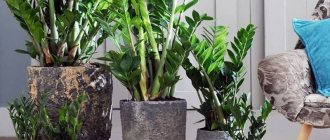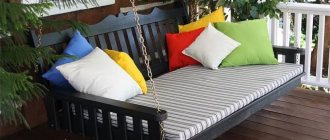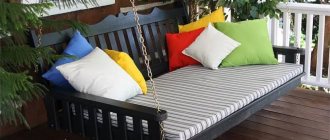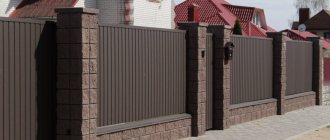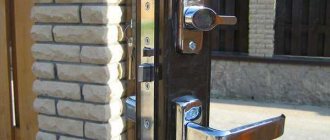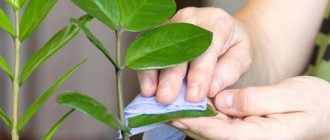- home
- Plant catalog
- Succulents
Reading time: 8 minutes
48768
Zamioculcas is a large herbaceous plant belonging to the araceae.
Sometimes it is also called the dollar tree. East Africa is considered its homeland.
It is characterized by very beautiful foliage and specific inflorescences, more like cobs , covered with a greenish blanket.
Despite its exotic nature, this flower is not picky, has great endurance and, with proper maintenance, grows well in ordinary city apartments.
But in order for Zamioculcas to develop properly, you need to know the rules for caring for it. One of them is transplantation.
- Zamokulkas: transplant after purchase
- Transplanting zamioculcas at home - basic rules When to replant
- Soil and drainage
- What pot for the plant
- How to properly transplant Zamioculcas
Features of the flower that determine the requirements for the vessel
Zamioculcas or dollar tree is popular among gardeners not only for its attractive appearance, but also for its ability to improve the financial situation of its owner. An unpretentious plant from the eastern part of the African continent has been decorating apartments and offices for a long time. However, in order for the flower to develop correctly and bring benefits, it is necessary to choose the right container for growing, taking into account the following features of the ornamental tree :
- Zamioculcas has thick stems and a voluminous crown, so the pot for growing it must be quite heavy and stable.
- The root system of the plant develops at a fairly rapid pace to the detriment of the green top; the planting container must be of the optimal size so that both the lower and upper parts of the tree are formed correctly.
- You need to know what conditions Zamioculcas does not like. This is primarily high humidity, but it also cannot tolerate drought. The growing plate should allow air to pass through well, and not retain liquid inside the earthen ball, but also not immediately release it into the pan.
Important! Peat and coconut pots are not suitable for growing dollar trees. They maintain optimal air exchange with the external environment, but do not retain moisture, which often leads to drying out of the soil.
Tips for beginners
When choosing a pot, you need to focus on the volume of the roots, and the previous container may be 2-3 cm smaller than the next one.
- More than the size of the pot, attention must be paid to the material from which it is made. The root system of Zamioculcas is so powerful that it can damage the container, which is made of high-quality plastic or fragile ceramics or glass.
- It is better to opt for clay pots with thick walls. In addition to its strength, such a pot allows air to penetrate inside and water not to stagnate.
- You need to remove the zamioculcas from the old pot very carefully, trying not to damage the roots.
- The presence of a drainage layer in the pot makes it easier to change the container.
- A young dollar tree is replanted in a transshipment manner, without disturbing the earthen ball and annually increasing the new pot by several centimeters.
- An adult flower can be replanted after 2-3 years or as needed; the older it is, the slower it begins to grow.
How to choose the right container in a store?
When choosing a container for planting zamioculcas, you must be guided by the following rule: the pot must have a sufficient number of large drainage holes .
A lack of them will lead to stagnation of moisture and rotting of the roots, and an excess will lead to drying out of the soil. It is important to choose the right bowl material:
- Clay . It allows air to pass through well and is safe for the plant. The disadvantage is the inconvenience when replanting the plant; getting the roots of the plant without damaging them from the clay pot is very problematic.
- Plastic . Harmful substances contained in plastic can negatively affect the condition of the tree. In addition, as the root system grows, the container may become deformed or crack. But when replanting, this is an ideal option; the plastic container can be cut and the plant can be removed without touching the roots.
Important! Glass containers are not suitable for growing zamioculcas. Excess moisture will be retained in such a container, which will lead to rotting of the root system. The exception is glass containers with a large number of drainage holes.
Which one is needed to plant a young plant?
The choice of container for planting is also determined by the age and size of the plant. If the leaf is just taking root, then you should choose a pot with a narrow bottom and a wider top to quickly grow the crown.
Another important condition is that the depth is not too great , but sufficient to accommodate drainage. However, the size should be small. The best option is a container that can accommodate the root system with a three-centimeter margin around the perimeter for a soil layer. Choosing a large pot for a small plant can lead to a number of problems with its health and development.
Which one is better to replant an adult succulent?
As soon as the root mass of the zamioculcas reaches the walls of the pot, it must be transplanted into a larger bowl. It should be slightly larger in diameter than the previous one (no more than 2-3 cm).
When replanting, it is important to consider the size of the plant itself . A tree with massive, densely growing trunks should be transplanted into a pot with a wide top. If the plant has small tubers and thin shoots, then preference should be given to an elongated flowerpot with a diameter slightly larger than the previous one (about 1-1.5 cm).
Zamokulkas: transplant after purchase
Zamioculcas transplantation cannot be carried out immediately after purchase. Having brought a flower home, it is first recommended to quarantine it. To do this, you need to place it for several weeks in a room where there are no other flowers. At this time, you need to water as needed and monitor the condition of the new pet.
When buying plants in a store, you can often not notice the presence of diseases and pests . If they are discovered during quarantine, appropriate treatment must be urgently carried out.
After the quarantine period has expired, the zamioculcas must be replanted. The fact is that the soil in which the plants are located in the store is transportable. It does not contain those substances that are required for the proper development and active growth of flowers.
At the same time, during transportation and maintenance in places of sale, watering is carried out with special means. Such soil absorbs water poorly, which can provoke the development of various diseases of the root system. Therefore, when transplanting, this substrate must be replaced with a nutritious soil mixture.
It is advisable to replant Zamioculcas in the spring (read about the ideal time for replanting indoor plants here). But, if the flower was purchased at another time, you should not adhere to this rule; you need to replant it no later than 3 weeks after purchase .
If Zamioculcas blooms, the buds will most likely fall off.
There is nothing wrong with this; on the contrary, the plant will have more strength to acclimatize.
The next flowering, as a rule, with proper care, occurs in the prescribed period.
Photos of flowerpots
Next in the photo you can see the options for containers for the dollar tree.
Creating a Mixture
First of all, it is necessary to lay expanded clay drainage in a layer of 3-4 cm .
The soil should be loose and soft. The following mixture is considered optimal: peat, turf, sand, leaf humus.
You can use ready-made soil for succulents and cacti, adding a little sand and humus to it. The substrate should be light and prevent the accumulation of moisture so as not to damage the plants.
Correct and timely replanting will allow you to grow a healthy plant that will decorate any interior of your apartment.
More information about the soil for Zamioculcas can be found here.
Can it be planted in a larger or tall container?
Zamioculcas should not be planted in a container that is too large . If you transplant the plant into a pot with a large diameter, the above-ground part will not develop until the roots reach the walls and occupy the entire lower part of the container.
The height of the pot should also be optimal. A bowl that is too deep will contain much more soil than required. And moistening the soil in such a container will be problematic; a large amount of liquid will be required, which will cause putrefactive processes in the root system. A pot with insufficient depth will not accommodate the drainage layer necessary for the proper development of the tree.
You should not choose a container with a wide bottom and narrow neck for planting . The green crown will be crowded, and the roots, on the contrary, will grow too much. It will be impossible to replant such a plant without breaking the container.
Diseases and pests affecting this species
Problems and illnesses are the result of illiterate care:
From the burning sun, brown spots appear on the leaves, and the foliage itself turns yellow. We need to shade the windows and add spraying. Zamioculcas abruptly drops small leaves - the air and substrate in the pot are too dry
To save it, it is important to optimize and streamline watering (long periods of drought are unacceptable). Overflow - sure and quick death of a succulent
Signs of waterlogging are the leaves turning yellow and withering, then the roots rotting. Wipe the leaf plates with a damp cloth to remove dust and dirt; this procedure will prevent the appearance of spider mites.
In conclusion, it should be emphasized that Zamifolia is an ideal indoor flower for busy people. Despite the measured rhythm of life (small annual growth), it develops steadily and withstands any “blows of fate.” The ornamental bush responds to signs of attention and caring attitude with abundant bright greenery.
What household containers might be suitable?
Plastic food buckets are suitable as a temporary pot when planting zamioculcas. The main thing is to make drainage holes in the container.
It is not recommended to use glass or tin jars , which do not allow air to pass through and retain moisture inside the soil, increasing the likelihood of putrefactive processes occurring in the root system.
The best option for planting zamioculcas is a ceramic pot with a wide top and a narrow bottom. In this case, it is important that there is a layer of soil between the root system and the walls of the bowl. It is equally important to choose the desired depth of the flowerpot; containers that are too deep will lead to problems with the growth and development of the plant.
Season
It is better to replant it in the spring . It is advisable to wait for the onset of warmth, this could be the end of March - beginning of April.
The only exception to the rule can be replanting the plant after purchase (it is done 1-2 weeks after the flower has adapted, regardless of the season) and rotting due to excessive watering (in this case, urgent replanting is required).
It is not recommended to replant the flower in winter and autumn .
You can find out more about how to properly plant Zemioculcas here.
When is the best time to replant?
The best time for replanting for both young and mature plants is spring; the most favorable months are March and April.
Experienced flower growers wait until the plant finishes flowering, and only then begin replanting, otherwise the plant will drop all its flowers.
Young plants are replanted annually, as their growth is intensive for up to 3 years. It is necessary for them not only to change the size of the container, but also the soil due to its depletion.
Mature specimens try not to be disturbed so often, especially since plant growth slows down with age, so they are replanted every 3-4 years.
If the moment is missed, the transplant can be done at the beginning of summer.
Some lovers of indoor plants believe that autumn replanting is possible without much discomfort for the flower, although experts consider this to be incorrect. During this period, the flower is preparing for a state of dormancy for the winter and all processes in the plant are inhibited, therefore, there will be no good survival rate.
